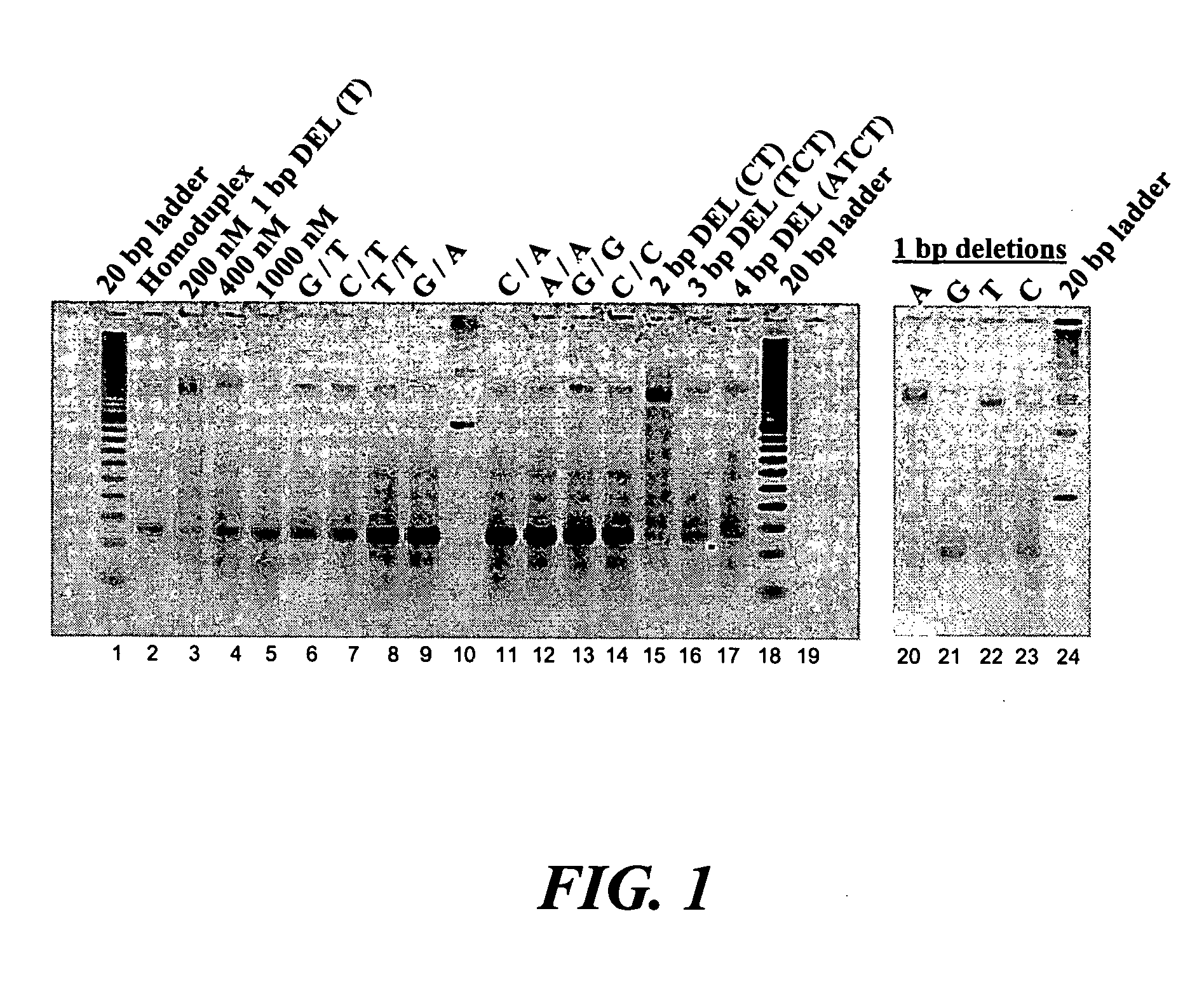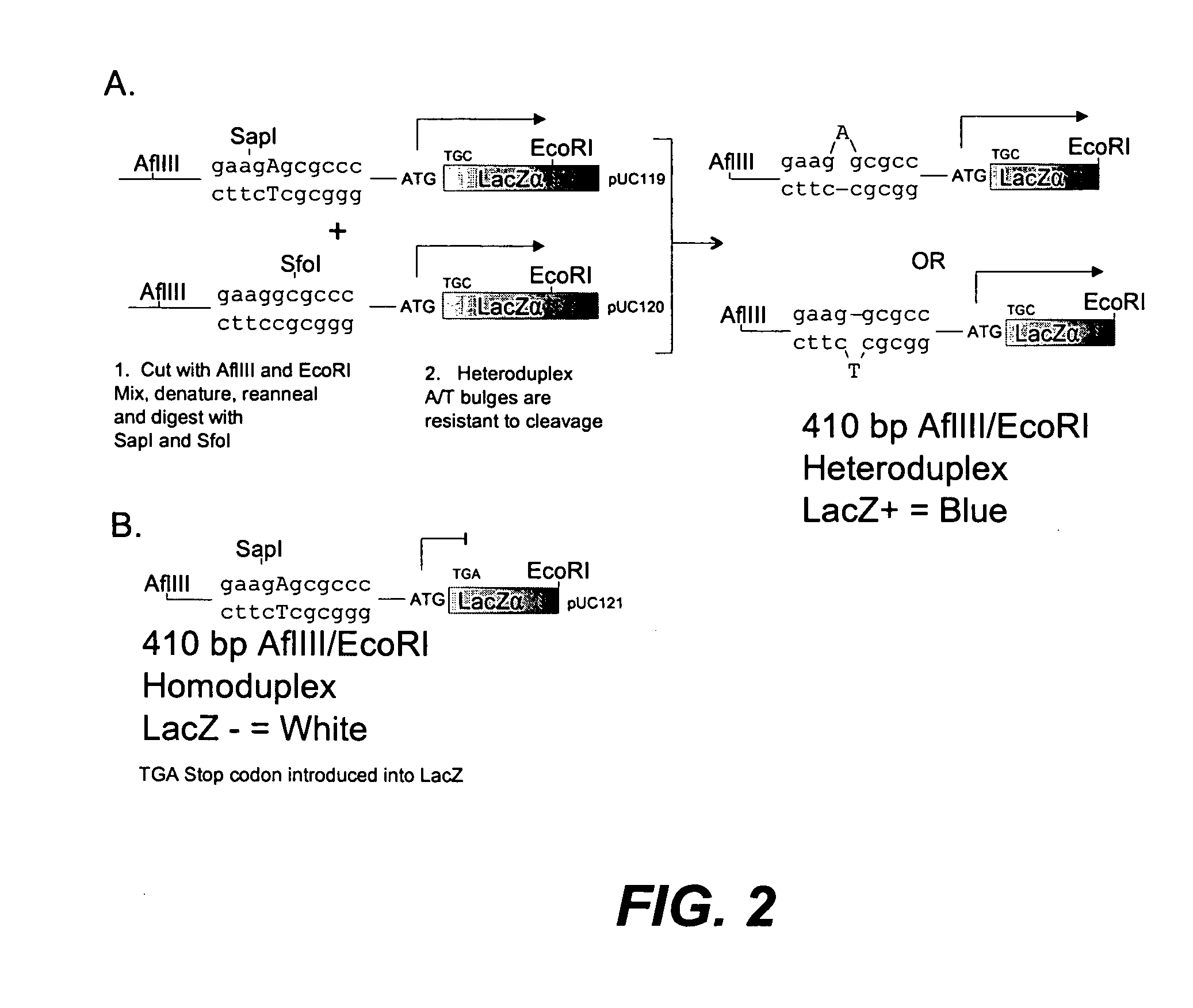Error reduction in automated gene synthesis
a gene synthesis and error reduction technology, applied in the field of double-stranded oligonucleotides removal, can solve the problems of large majority of error containing strands, mismatches are converted into base paired errors in sequence, and base errors in single-stranded oligos
- Summary
- Abstract
- Description
- Claims
- Application Information
AI Technical Summary
Benefits of technology
Problems solved by technology
Method used
Image
Examples
example 1
Mismatch Binding with Taq MutS and Gel Analysis
[0083] Representatives of the MutS family of proteins are found in a wide variety of organisms, any of which may be useful in this invention. Thermus aquaticus MutS (TaqMutS) is a typical MutS protein, binding loops of 1-4 nucleotides with high affinity as well as all the combinations of mismatched bases with the exception of C to C mismatches. In this example the ability of TaqMutS to bind a defined heteroduplex and removal of the resulting protein-DNA complex is demonstrated.
[0084] Mismatch binding experiments were carried out in 10 or 20 ul total volume in 20 mM HEPES pH 7.5, 5 mM MgCl2, 0.1 mM EDTA, 0.1 mM DTT, 50 ug / ml BSA and 5% (v / v) glycerol. The reaction mixture contained 200 nM of DNA duplex and 1 uM of Taq MutS unless otherwise indicated. The mixture was incubated at 60° C. for 15 minutes and cooled to 4° C. Gel shift analysis was done on 5% acrylamide gel cast in 1× TBE and 10 mM MgCl2.
[0085] Gel shift assays with Taq Mut...
example 2
Binding of TaqMutS to Defined Test Heteroduplex DNA and Removal of Protein-DNA Complexes
[0086] A test heteroduplex fragment linked to a gene fragment that results in a blue colony phenotype when cloned directionally into a pUC vector was generated. A 410 bp AflIII / EcoRI fragment that included the start codon and 5′ coding region for an active LacZα gene was generated containing a single A or T deletion heteroduplex upstream of the LacZα gene. The same homoduplex 410 bp fragment was created with a single base change resulting in a stop codon in the 5′ coding region of the LacZα gene. In this way the heteroduplex fragments are linked to an active fragment of the LacZα gene, while the homoduplex molecules are linked to an inactive LacZα gene fragment. Ligation of the active or inactive N-terminal LacZα fragment to restore a complete LacZα gene allows heteroduplex or homoduplex molecules to be scored by counting blue or white colonies when grown on media containing X-Gal. The scheme fo...
example 3
Binding of TaqMutS to a 354 BP Synthetic DNA and Removal of Protein-DNA Complexes
[0088] Direct binding of TaqMutS to synthetic DNA was determined as follows. 500 nM TaqMutS was incubated with 40 nM 354 bp synthetic DNA at 60° C. for 20 minutes. DNA obtained following treatment with Micropure-EZ enzyme removal columns (Deproteination), was cloned and sequenced. The results are displayed below in Table 2.
[0089] Only 2 out of 15 clones sequenced in the no treatment control group had the correct sequence, representing an error frequency of 1 / 212 base pairs. The Micropure-EZ enzyme removal column flow-through deproteinated fraction showed substantial improvements (1 / 1593 P<0.001). Over 85% of all errors were removed in the Micropure-EZ column deproteinated fraction when compared to the no treatment control DNA.
TABLE 2TaqMutS binding and removal of synthetic DNA-protein complexesAve. #Error# Fully# Correct# Total%Error / FrequencyTreatmentSequencedSequenceErrorsCorrectfragment(1 / x bp)P ...
PUM
| Property | Measurement | Unit |
|---|---|---|
| volume | aaaaa | aaaaa |
| size | aaaaa | aaaaa |
| length | aaaaa | aaaaa |
Abstract
Description
Claims
Application Information
 Login to View More
Login to View More - R&D
- Intellectual Property
- Life Sciences
- Materials
- Tech Scout
- Unparalleled Data Quality
- Higher Quality Content
- 60% Fewer Hallucinations
Browse by: Latest US Patents, China's latest patents, Technical Efficacy Thesaurus, Application Domain, Technology Topic, Popular Technical Reports.
© 2025 PatSnap. All rights reserved.Legal|Privacy policy|Modern Slavery Act Transparency Statement|Sitemap|About US| Contact US: help@patsnap.com



